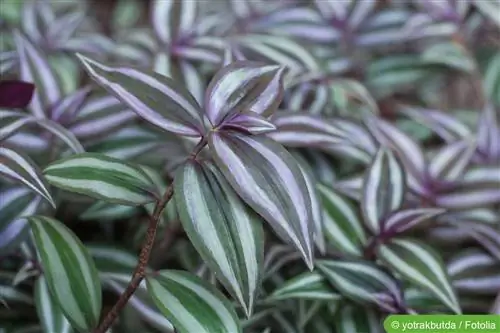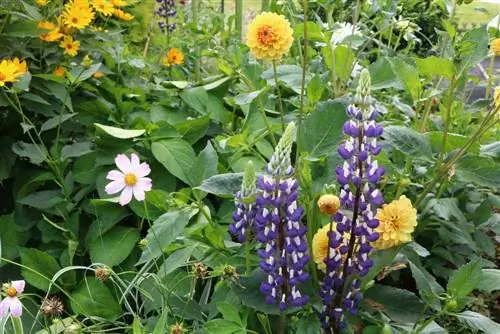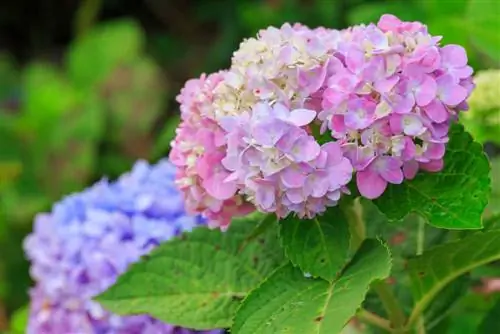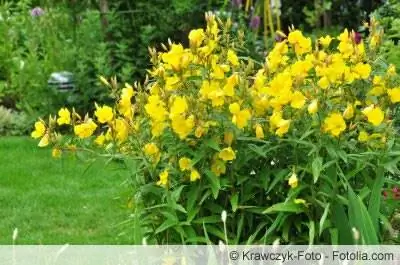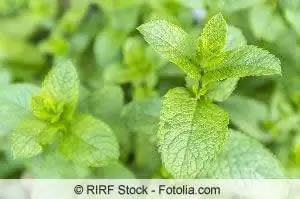- Author admin [email protected].
- Public 2023-12-17 03:39.
- Last modified 2025-01-24 12:45.
The zebra herb is an undemanding and very vigorous plant that has a particularly decorative effect. Due to its variety of colors, it is a houseplant found in many households.
Appearance of Zebraweed
The zebra herb, which comes from Mexico, has a very special coloring on the four to ten cm long, fleshy leaves. The houseplant can be colored very differently. Variants with a strong green colored upper side, two silver-white stripes and a purple colored underside are just one of the diverse colorings. There are also many other shimmering leaf colors that are decorated with red, white or silver stripes. The oval, evergreen leaves have no stem and hang on long shoots. This makes them particularly attractive for growing in hanging baskets. The plant produces small, inconspicuous flowers, each with three leaves, throughout the year. These can appear in colors ranging from pinkish red to purple.
Zebra weed species
The most common species is the Tradescantia Zebrina, which is particularly robust and colorful and can be found in many varieties. Hardy plants can also be found among the different species. The three most popular types at a glance:
Zebrina pendula
This very well-known variant has green leaves with shimmering silver stripes. The underside of the leaves is crimson. This plant flowers purple-pink. Many of the other species are descended from this genus.
Zebrina pendula quadricolor
This species is similar to Zebrina pendula and differs only in the color of the stripes on the leaves. These can come in green, silver, pink or creamy white. The flowers are red to purple.
Zebrina purpusii
The upper side of the slightly larger and hairy leaves has very faint brownish-purple stripes, while the base color is a strong bronze tone. The flowers are delicate purple.
Zebraweed location
The zebra herb feels most comfortable in the brightest possible locations. If this is the case, the colors of the leaves can develop better and the plants grow more slowly, which ensures denser growth. The more light these plants receive, the stronger and brighter the colors become. The exclusively green colored variants are also happy with a shadier location.
The zebra herb feels at home both indoors and outdoors. It prefers an airy place, ideally on the terrace or balcony. However, direct sunlight should be avoided. A window seat is ideal in the house. In summer, temperatures between 20 and 24 °C are recommended. When overwintering, the frost-sensitive plant can tolerate cold temperatures of up to 7 °C, but slightly higher values between 12 and 15 °C are better. At higher temperatures in winter, the leaves fade slightly.
Caring for Zebraweed
The zebra herb can be planted in normal potting soil, but the plant is also grateful for compost soil. Watering should be done sparingly. A little water once a week is completely sufficient. The soil should always dry out a little until the plant is watered again. This is how the plants achieve their most beautiful color. Low-lime or even lime-free water is recommended. Waterlogging must be avoided at all costs, as the roots can easily rot. During the winter months, the zebra herb is rarely watered. Just enough water is given so that the soil never completely dries out.
The houseplant has a very low nutrient requirement. During the main growing season it should be fertilized with liquid fertilizer every 14 days. Once the plant's roots have completely filled the flower pot, it's time to plant the zebra herb in a larger pot. This ideally happens in spring. The zebra herb grows very quickly into a dense plant. The older the plant gets, the bare it becomes. It is therefore advisable not to let the houseplant grow longer than 30 cm, otherwise it will no longer look much. To maintain the beauty of the herbaceous plant and achieve a bushy growth, the terminal buds should be removed at regular intervals. If the plant has become bare at the bottom, it can easily be cut back completely in the spring. After just a short time, new, beautiful shoots will form again.
Propagation of Zebraweed
The propagation of zebra herb is very easy using cuttings. To do this, individual shoots of the plant, approximately 7 cm long, are cut off in spring or summer and can be put into a pot with soil or a compost-soil mixture without any problems. After just one or two weeks, the plants will begin to grow. It is also possible to place the cuttings in a glass of water. After just two to three weeks, the small plants have strong roots and can be planted in a flower pot. To get a bushy-looking plant, it makes sense to put several cuttings in one pot.
Diseases, pests and application errors
The zebra herb is not very susceptible to pests and diseases. Application errors, such as frequent drying out of the pot balls, can result in brown leaf edges. The most important data at a glance:
- Growth height: about 30 cm
- Special features: flowers that occur all year round, many colorful variations available
- Flowering time: spread throughout the year
- Location: bright, airy, 20-24 °C in summer, 12-15 °C in winter
- Watering: moderately, let the soil get slightly dry again and again
- Fertilize: every 2 weeks with liquid fertilizer
- Pruning: regularly break out the tips of the longer shoots
- Pests: rarely occur
- Diseases: hardly susceptible
- Propagation: by cuttings
The zebra herb is particularly suitable for beginners due to its easy-care properties. Since propagation is very easy, even newcomers to gardening can quickly achieve their first successes. The plant also forgives user errors such as short-term drought and even if it reacts with brown leaves, it usually sprouts again after a complete pruning.
What you should know about zebra herb in brief
The zebra herb belongs to the Zebrina plant genus. It is also known by the name Zebrina pendula and the zebra herb is a very fast growing plant. Because the plant grows so quickly and so much, it is ideal for balconies and gardens and is primarily cultivated in hanging baskets. Its flowers are long and oval and they shine in strong colors. The main tone of the flowers is green and they have two silver-looking stripes. The lower side of the heavily flowering leaves is colored purple. The flower consists of three leaves and it blooms continuously from spring to summer and is therefore ideal for contrasting planting in the garden and in balcony boxes.
The Zebrina pendula is the main genus of the species. Its subspecies are Discolor, Purpusii and Quadricolor. The Zebrina is extremely common and its flowers shine in a strong purple or deep pink:
- The Discolor has thinner leaves. On their sides you can see two thin silver stripes. The leaf is bronze-like in the middle.
- The Purpusii has large and hairy leaves. Its colors range from white to purple and it lacks the longitudinal stripes of other varieties.
- The Quadricolor, on the other hand, has very pronounced edge stripes. Their colors are pink, yellow and silver-white.
The zebra herb prefers a bright location. A little direct sunlight is good for it, because if it gets too little light, the flowers become pale and the plant grows poorly. The Zebrina pendula is only watered very rarely. In order for the flowers to shine brightly, it must always have a little dried out plant substrate, only then should it be watered next time.
- The zebra herb likes warm temperatures between 20 and 25 degrees Celsius.
- It also thrives at 12 degrees, but that is the lowest limit and should be avoided if possible.
- The plant propagates via cut head cuttings, which take root very quickly even in groupings.

